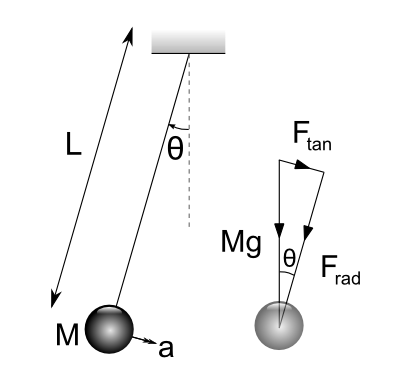Or search by topic
Number and algebra
Geometry and measure
Probability and statistics
Working mathematically
Advanced mathematics
For younger learners
The Not-so-simple Pendulum 1



- Problem
- Getting Started
- Student Solutions
- Teachers' Resources
We were sent a wonderfully detailed solution by Ben from Kenny. He has formatted it beautifully, so we are including his pdf directly. It is well worth reading through.
Furthermore, one of our vacation summer students produced the solution given here.
Equation of motion

Considering the forces acting on the pendulum bob acting in the tangential direction
$$F_{tan} = Mg \sin \theta$$
Newton's Second Law:
$$\sum_{i}\mathbf{F_i} = \frac{d}{dt}(m \mathbf{v})$$
Applying tangentially:
$$\Rightarrow M a_{tan} = M g \sin \theta \ \Rightarrow \ a_{tan} = g \sin \theta$$
Changing from translational to angular acceleration $a_{tan} = -\ell \ddot{\theta}$ (negative sign due to opposing directions):
$$\Rightarrow-\ell \ddot{\theta} = g \sin \theta$$
$$\therefore \ddot{\theta} = \frac{-g}{\ell} \sin \theta $$
This is a second-order non-linear differential equation in $\theta$. It cannot be solved easily due to the $\sin \theta$ term. An analytical solution is possible, using what are called elliptical integrals, though it is not reducible to elementary functions.
Comparing with $\ddot{\theta} = -k^2 \sin \theta $ gives
$$k^2 = \frac{g}{\ell} \Rightarrow \ell = \frac{g}{k^2}$$
$$k = 0.1 \Rightarrow k^2 = 0.01 \Rightarrow \ell = 100g = 981\textrm{ m}$$
$$k =1 \Rightarrow k^2 = 1 \Rightarrow \ell = g = 9.81\textrm{ m}$$
$$k =10 \Rightarrow k^2 = 100 \Rightarrow \ell = \frac{g}{100} = 0.0981\textrm{ m}$$
Linearisation using small-angle approximation
The Taylor series expansion of the sine function is:
$$\sin \theta = \theta - \frac{\theta^3}{3!} + \frac{\theta^5}{5!} - \frac{\theta^7}{7!} + O(\theta^9)$$
(where $O(\theta^7)$ indicates terms in $\theta^9$ and above, sometimes called Big-O notation).
For 'small' $\theta$, $O(\theta^3) \ll \theta$ and so $\sin \theta \approx \theta$. 'Small' here has intentionally been left vague as the next part of the question is to consider the validity of this assumption.
To find the range of values for which $\sin \theta$ lies within 1% of $\theta$, find the point at which $\sin \theta$ is exactly $0.99\theta$ (i.e. 1% less).
$\sin \theta = 0.99 \theta$ by numerical methods $\Rightarrow \theta = \pm 0.24532\ \textrm{rad} = \pm 14.1^\circ$
You may also like
It's Only a Minus Sign
Solve these differential equations to see how a minus sign can change the answer
Differential Equation Matcher
Match the descriptions of physical processes to these differential equations.
Taking Trigonometry Series-ly
Look at the advanced way of viewing sin and cos through their power series.

